Where's the Air?
You can't see it, but you can feel it. You know it is there, and whether you know it or not, you are affected by it every day. What is it? Air! The millions and millions of air molecules constantly move in all directions. The molecules bump and bounce into everything in their path with a lot of energy. This is how air exerts pressure. In this experiment, you will play with air and air pressure. Do this activity with a partner.
What you need- 2 identical empty clear plastic soda bottles (with screw on caps)
- Push pin
- Clear deep container for water (aquarium, sink)
- Balloon
- Pencil
- Remove the bottle cap from one of the plastic bottles and place the opened bottle down in the large container of water.
- Push the bottle down in the water about 8-10cm. Make sure that the water in the large container does not overflow.
- Watch what happens at the open end of the bottle. Did any water come into the bottle? What's keeping more water from entering in?
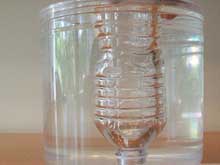
- Tilt the bottle to the side and allow some of the air to escape. What happened to the water level inside the bottle?
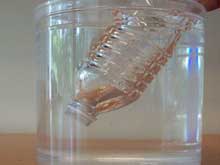
- Use the push pin and poke a hole carefully in the side of the bottle near the bottom. What happens to the level of water in the bottle?
- Try doing this again by emptying the bottle into the large container and cover the hole from step 5 and place the bottle upside down into the water. Take your finger off of the hole. What happens? (NOTE: If water enters the bottle slowly the hole should be made a little larger.)
- Place the bottle at the edge of your sink. Fill the bottle with water and watch as the water streams out of the hole into the sink. After a few seconds, use the palm of your hand to cover the mouth of the bottle. What happened to the water that was coming out of the hole?
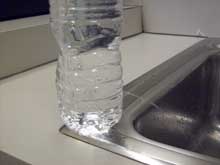
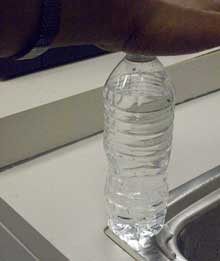
- Take the bottle cap and screw it on the bottle. Hold the bottle on its side with the hole facing down. What happens to the water in the bottle?
- Stand the bottle upright and loosen the cap. What is going on with the water? Now tighten the cap and observe.
- Remove the cap and place a balloon on the mouth of the bottle. Does water leave the hole while the balloon is on? What do you notice about the balloon as the water comes out? What has happened to the balloon when the water has stopped?
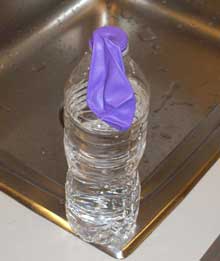
- Pull up on the balloon and let it go. Observe the hole and pull upward on the balloon again. Why does air come in when you pull up on the balloon?
- Use a pencil to make a pin hole in the bottle. Make sure it is the same size as the hole made with the push pin.
- Put your finger over the hole and fill the bottle with water.
- Your partner should fill the other bottle with water.
- When you say “go”, take your finger off of the hole and turn the bottles upside down over the sink. Which one empties first?
Even more fun…
Try steps 5 thru 8 and observe what takes place now that there is a bigger hole in your bottle.
Where is the physics?
In steps 1 through 6, the water does not enter the upside down bottle because the bottle is already occupied by air. When a hole is placed in the side of the bottle the water pushes up from the bottom. At this point, the air in the bottle is at higher pressure than the atmosphere, so the hole allows air to escape and the water to rise in its place.
In step 7, the water falls due to gravity. When you cover the top of the bottle, you are cutting off the flow of air and creating a vacuum inside the bottle. The vacuum keeps the water suspended in the bottle and water stops coming out. When the balloon is stretched across the mouth of the bottle, and the hole is uncovered, water will come out and air will leave the balloon. As the water leaves the bottle, no outside air can come to replace it. The result is that air pressure in the space between the balloon and the water surface is lowered. The outside air pressure is now higher than the inside; air can now push the balloon into the bottle.
Check these out for more air pressure fun:
http://youtu.be/WkGoG9g1QX4
http://youtu.be/Wx--w-gyblA











